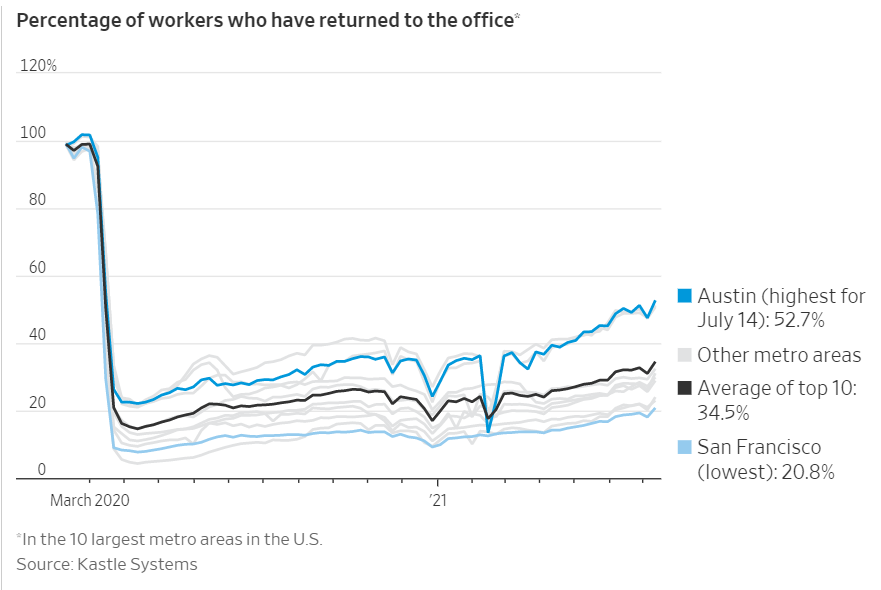We’ve written that leaving the office was trivial, at least in retrospect–“fire alarm’s going off, everyone leave the building”–but that returning is going to pose one of the most complex financial-cultural-operational-technological-recruiting & retention-organizational challenges that law firms have faced for years.
And not surprisingly, you hear a cacophony of views and predictions; more ink pixels have been spilled on this topic over the past few months than anything else by an order of magnitude.
We would like to try organizing the various issues into some sort of coherent framework and perhaps suggesting a few ways forward.
What we can say with a high degree of confidence
The emerging equilibrium once things settle down will not be:
- Everyone back in the office five days a week; not
- Everyone working remotely five days a week;
- Not a free-for-all what you want/when you want it;
- And when your lease comes up for renewal, you will downsize. Seriously downsize.
So if there’s going to be de facto some kind of hybrid model, how do we make the best of it? And how do we know what it’s going to look like? As the crack about predicting the future goes, you’re safe if you predict what will happen or when it will happen but not both.
(Speaking of when, a brief digression on the nasty and extremely unwelcome Delta variant: This is obviously causing companies, schools, universities, arts and sports organizations, and every other congregant venue to reconsider what plans they had in place as recently as two to six weeks ago. But–fully recognizing the human toll now being inflicted yet again when we are all so g.d. sick and tired of it–this will not change the long-run equilibrium. Delay, yes, different endpoint, no.)
Law firms entering uncomfortable (but welcome!) territory
Let’s back up for moment to how we got here: Starting around March 2020, we learned:
- Law firms can, believe it or not, pivot on a dime when it comes to functions as basic as how lawyers and staff do their (solo) “screen” work, meet with colleagues, connect with clients, “go to” court, collaborate on deals, form and disband project teams, recruit new hires, and much much more.
- But before we give the “firms” too much credit, the performers in this stunningly acrobatic adjustment were: Human beings. Humans are far more adaptable, far more quickly, than they’re commonly given credit for. This was not a top-down driven performance, it was bottom-up from the get-go.
- And if it could happen once, it could happen again–that’s the key learning here.
- We may have the opportunity to test that adaptability “in reverse,” as it were, when offices start reopening.
There will be no one-size-fits-all “solution.” Already, we have seen major metro areas diverge markedly in how quickly they are reoccupying their offices: Dallas, Houston, Austin, Phoenix and Miami, for example, at nearly 50% occupancy while New York and San Francisco are at 20% on a busy day. (These are commercial real estate industry figures, not Law Land specific figures, but let’s assume they’re a good approximation for us.)
On that same note, a fascinating phenomenon was reported in The Wall Street Journal last week: “For Home Buyers, Length of Commute Drops in Importance.” The headline says it all, but data from major metros indicate house prices rising faster in remote areas than close in to the city centers. Zoom is here to stay.
So far, public announcements from firms are, well, all over the place
Some firms are saying they expect pretty much all hands back in the office this fall. Others (impressionistically, the tech-centric firms) have said everyone is free to keep working remotely for as long as, well, until we tell you otherwise. Some are telling their lawyers and staff to, essentially, figure it out for themselves: “Teams need to do what works best for them,” for example.
And perhaps the most common reality on the ground was captured by a client we were talking with this week who, when we asked what his firm’s return-to-the-office policy was, responded with one word, “Unclear.”
At Adam Smith, Esq., as regular readers know, we try to make a concerted habit of looking outside Law Land for learning from corporate America, multinationals, other professional service firms, and industries like tech, the media, insurance, manufacturing, and more. So what do we see there? The same phenomenon, frankly: Policies and realities are all over the place.
Generally speaking, tech is most comfortable with a very high quotient of remote work for as far as the eye can see. At the other extreme, all the B2C businesses that involve one-on-one personal service delivery have never been there and never will or could be. In short, firms are going to have to experiment, like it or not, with what works for them. Our industry’s favorite fallback/refrain when mulling a policy decision has long been “What are other firms doing?” If you’re looking for consensus, this will get you nowhere.
While we’re on the topic of variety-of-outcomes, here’s an other dimension we confidently predict will not be one-size-fits-all, and it applies within your own firm, not just to your firm vs. everyone else: The relative proportion of office:remote work will be driven strongly by:
- Generational differences: younger in the office more, to build their networks, learn the ropes (a/k/a “apprenticeship”), socialize and absorb and internalize the firm’s culture, etc.;
- Practice area differences: Tax lawyers may need to come in the office once or twice before your firm’s Holiday Party, but litigation associates will need a front-row, in-person seat to almost everything.
- Corporate/transactional may experience cyclic ups and downs:
- Office-heavy when teams are being put together, engagements scoped out, and marching orders determined.
- Remote-heavy during negotiations and drafting.
- And back to the office for final details, triple-checking everything, and closing.
Should clients have a say?



